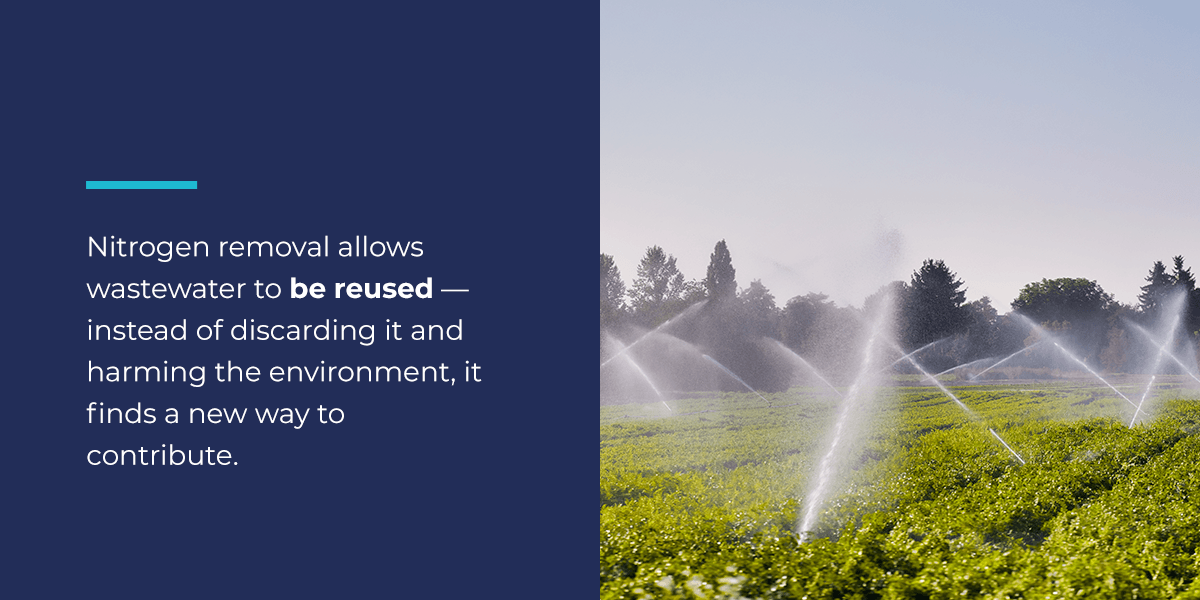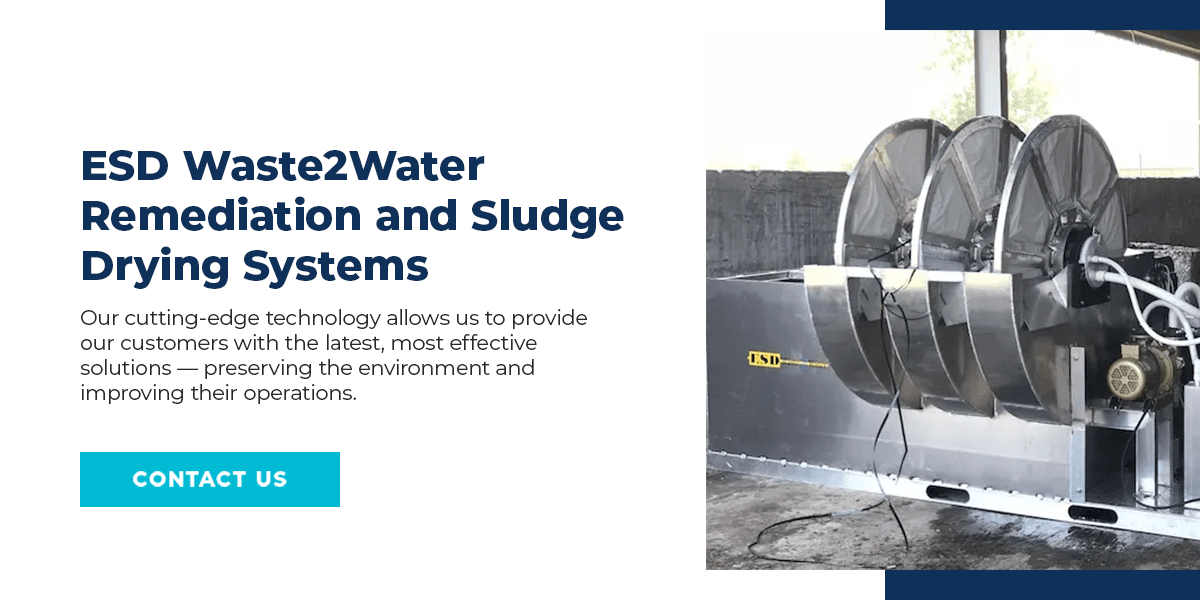
Water is an essential component of many industries. It provides cooling, nutrients and more to processes ranging from agriculture to landscape maintenance. Once water is used in an industrial process, it often contains excess chemicals or nutrients that must be treated or removed to protect environmental and public safety.
Nitrogen is a major environmental concern in wastewater. Excess nitrogen can cause many environmental issues that have a ripple effect, damaging local ecosystems where wastewater is released. One form of wastewater treatment is nitrogen removal. Various processes are used to reduce the amount of nitrogen in wastewater, making the water safe for reuse or release into the environment. Understanding why nitrogen removal is necessary and how it works is essential for building safe wastewater treatment processes.
Why Removing Nitrogen From Wastewater Is Essential
Nitrogen is an essential nutrient that plays a significant role in creating and feeding life. While it occurs naturally, especially in bodies of water, it’s also a critical component in many fertilizers. It helps promote plant growth and provides essential nutrients. However, the significant amount of commercial fertilizers used today has led to large amounts of excess nitrogen in water runoff. Not all nitrogen gets absorbed, and the excess is washed away by rain into streams, lakes and rivers.
While some excess is fine, the abundance of nitrogen in wastewater can severely affect local ecosystems. Excess nitrogen stimulates algae growth in water. Too many algae stifle decreased dissolved oxygen levels and block sunlight for life below the algae in the water. All of these factors caused by excess nitrogen throw the ecosystem out of balance and harm the overall success of other organisms and environmental conditions.
Wastewater Applications After Nitrogen Removal
There are several applications for wastewater once nitrogen is removed. Nitrogen removal allows wastewater to be reused — instead of discarding it and harming the environment, it finds a new way to contribute. Removing nitrogen from wastewater can be energy-intensive, but the reuse capabilities make it well worth it.

Here are some of the most common applications for wastewater reuse:
- Golf courses: Golf courses require massive amounts of water to maintain their vibrant green space. Treated wastewater has excess nitrogen removed so that it won’t impact local ecosystems. Golf courses can safely use wastewater to maintain their courses without using fresh, drinkable water or harming organisms.
- Agriculture: Wastewater cleared for safe environmental reuse but not quite safe enough to consume directly works well in agriculture. The agricultural industry can safely grow their crops with treated wastewater and reserve drinking water for consumers. However, plants need nitrogen to grow, and the wastewater has little after treatment. While plants can get the necessary fuel from the water, they will need nitrogen fertilizers added back into their diet.
- Industrial processes: Many industrial processes require water for their operations. This wastewater cycles through their industrial processes and then is treated. Once treated, the wastewater can be reused in these facilities once more.
- Firefighting: Fire suppression uses water to help protect the community. Treated wastewater is abundant and works well as a fire suppression tool.
- Commercial laundry and car washing: These industries require water for essential cleaning services. With wastewater, they can reuse water to reduce waste and provide cleaning services to their customers.
Each state has its own requirements for wastewater treatment. Wastewater must be treated to specific safety levels depending on its intended secondary use. The closer the wastewater’s contact with people, the stricter the safety regulations. Wastewater much be treated correctly to ensure the safety of the environment and the public. For example, wastewater used in concrete does not have to be treated to the same level as wastewater used in golf courses or crops since it will not contact the public like landscape irrigation does.
How Is Nitrogen Removed From Wastewater?
There are several nitrogen removal processes for wastewater treatment. Wastewater nutrient removal falls into two main categories: chemical and biological. Chemical removal of nitrogen from wastewater is a much more expensive process, while biological is less costly but involves more monitoring to get it right.
One of the most common biological methods is the activated sludge process, which uses nitrification-denitrification to remove nitrogen from wastewater. Nitrification involves specialized bacteria converting ammonia into nitrites and then nitrates. When nitrogen breaks down, it turns into ammonia — this high ammonia concentration created by excess nitrogen breakdown is toxic to ecosystems if released through wastewater.
After nitrification turns ammonia into nitrite and then nitrate, it must be converted into nitrous gas. Once this process, called denitrification, converts the nitrates into gaseous nitrogen, it can be released into the atmosphere without harming the environment. A blend of aerobic bacteria species and other microorganisms carries out denitrification. This culture is carefully developed for use in the activated sludge process and looks brown.
For the activated sludge process, wastewater is passed through filters with the bacteria-filled sludge. The bacteria eat the oxygen in the nitrates and nitrites, turning them into nitrogen gas. The nitrogen is released into the atmosphere harmlessly, and the now oxygen-depleted wastewater goes through an aeration process to restore its normal oxygen levels. With the excess nitrogen removed, the wastewater can be repurposed for other uses.
Conditions Necessary for Good Nutrient Removal From Wastewater
Both nitrification and denitrification require different conditions to complete their intended processes successfully. These processes cannot work without the right conditions, so maintaining them is essential. Nitrification requires aerobic conditions, and denitrification requires anoxic conditions to work.
- Aerobic: Aerobic conditions have free and dissolved oxygen readily available in an aqueous environment.
- Anoxic: Anoxic conditions have oxygen available only in a combined form like sulfate, nitrate or nitrite in an aqueous environment.
Without aerobic conditions, nitrification cannot occur — the bacteria need oxygen to fuel the process. Similarly, denitrification requires anoxic conditions to facilitate the removal of oxygen to create nitrogen gas. Facilities treating wastewater for nitrogen removal will adjust the water composition to maintain these conditions.
ESD Waste2Water Remediation and Sludge Drying Systems
ESD Waste2Water provides industry-leading equipment and solutions in wastewater management. From design and manufacturing to installation and training, we have all the services you need to develop and refine your environmental remediation equipment and wastewater treatment needs.
At ESD Waste2Water, we understand the importance of protecting the environment. Our cutting-edge technology allows us to provide our customers with the latest, most effective solutions — preserving the environment and improving their operations. With unmatched customer service and worldwide clientele, we have the experience and reach necessary for advanced Biological, reliable remediation, Ferrate solutions and sludge drying systems.
If you’re interested in advanced bioremediation solutions or want to know more, contact ESD Water2Water today!


